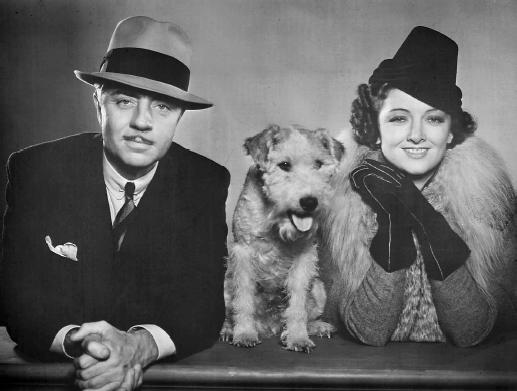The Thin Man - Film (Movie) Plot and Review
USA, 1934
Director: W. S. Van Dyke
Production: Metro-Goldwyn-Mayer Picture Corp.; black and white, 35mm; running time: 91 minutes. Released June 1934. Filmed during 12 days (some sources list 16 days) of 1934 in MGM studios.
Producer: Hunt Stromberg; screenplay: Albert Hackett and Francis Goodrich, from the novel by Dashiell Hammett; photography: James Wong Howe; editor: Robert J. Kern; sound recordist: Douglas Shearer; art director: Cedric Gibbons; music: Dr. William Axt; costume designer: Dolly Tree.
Cast: William Powell ( Nick Charles ); Myrna Loy ( Nora Charles ); Maureen O'Sullivan ( Dorothy Wynant ); Nat Pendleton ( John Guild ); Minna Gombell ( Mira Wynant Jorgensen ); Porter Hall ( MacCauley ); Cesar Romero ( Chris Jorgensen ); Henry Wadsworth ( Tommy ); William Henry ( Gilbert ); Harold Huber ( Nunheim ); Natalie Moorhead ( Julia ); Edward Brophy ( Morelli ); Edward Ellis ( Clyde Wynant ); Cyril Thornton ( Tanner ); Thomas Jackson ( Reporter ); Ruth Channing ( Mrs. Jorgensen ); Gertrude Short ( Gloria ); Walter Long ( Study Burke ); Clay Clement ( Quinn ); Rolfe Sedan ( Kellner ); Bert Roach ( Foster ); Creighton Hale ( Reporter ).
Publications
Books:
Cannom, Robert, Van Dyke and the Mythical City of Hollywood , Culver City, California, 1948.
Baxter, John, Hollywood in the Thirties , New York, 1968.
Nolan, William, Dashiell Hammett: A Casebook , Santa Barbara, 1969.
Higham, Charles, Hollywood Cameramen , Bloomington, Indiana, 1970.
Everson, William K., The Detective in Film , Secaucus, New Jersey, 1972.
Cawelti, John, Adventure, Mystery, Romance , Chicago, 1976.
Quirk, Lawrence J., The Films of Myrna Loy , Secaucus, New Jersey, 1980.
Francisco, Charles, Gentleman: The William Powell Story , New York, 1985.
Kotsilibas-Davis, James, and Myrna Loy, Myrna Loy: Being and Becoming , New York, 1987.
Van Dyke, W.S., W.S. Van Dyke's Journal: White Shadows in the South Seas, 1927–1928: and Other Van Dyke on Van Dyke , Lanham, 1996.
Articles:
New York Times , 30 June 1934.
Variety (New York), 3 July 1934.
New Republic (New York), 25 November 1934.
Stage (New York), January 1937.
Jacobs, Jack, "William Powell," in Films in Review (New York), November 1958.
Ringgold, Gene, "Myrna Loy," in Films in Review (New York), February 1963.
Braun, E., "Myrna Loy on Comedy," in Films and Filming (London), March 1968.
Dumont, Hervé, "Woody S. Van Dyke et l'age d'or d'Hollywood," in Travelling (Lausanne), no. 37, 1973.
Sanders, Gregory, in Cinema Texas Program Notes (Austin), no. 1, 1975.
Dumont, Hervé, "W. S. Van Dyke (1889–1943)," in Anthologie du cinéma , Paris, 1975.
Black, Louis, in Cinema Texas Program Notes (Austin), 18 January 1978.
Roddick, Nick, in Magill's Survey of Cinema 4 , Englewood Cliffs, New Jersey, 1980.
"James Wong Howe," in Film Dope (London), November 1982.
Tessier, Max, in Image et Son (Paris), November 1982.
Buckley, M., "A Tribute to Myrna Loy," in Films in Review (New York), May 1985.
Reid's Film Index (Wyong), no. 5, 1990.
Szebin, Frederick C., "Hammett Rewritten," in Films in Review (New York), vol. 45, no. 7–8, July-August 1994.
Drees, R., " The Thin Man : Dashiell Hammett and Hollywood," in Films in Review (New York), vol. 46, September/October 1995.
* * *
The Thin Man is one of the brightest and most sophisticated comedy/mysteries of the 1930s. Based on Dashiell Hammett's novel of the same name, the film combines the elements of a classic detective story with overtones of the screwball comedies that had their heyday during the Depression. The result is a lighthearted murder mystery featuring perhaps the most engaging married couple in Hollywood's history: Nick and Nora Charles.
Screenwriters Frances Goodrich and Albert Hackett capture both the wit and the style of Hammett's original story. As is true of all good mysteries, strong character development is central to The Thin Man 's success. In the wealthy, fun-loving Charleses, film-going audiences

Dashiell Hammett is said to have modeled the Charleses on his own long-standing relationship with playwright Lillian Hellman, but for film enthusiasts the characters have become inextricably tied to the performers who brought them life. For both William Powell and Myrna Loy, The Thin Man represented a critical career milestone. Each had worked extensively in silent films, Powell playing dapper villains and Loy finding herself cast repeatedly as exotic vamps. The film's popular success, however, established Powell as a wisecracking, debonair leading man, while Loy's delightful portrayal of Nora was the beginning of her reign as Hollywood's "ideal wife." Over the next decade, the two would recreate their roles in five "Thin Man" sequels, and although none of the subsequent films ever quite equalled the effortless charm of the original, Powell and Loy remained perfectly paired throughout the series.
Goodrich and Hackett's script must share credit for The Thin Man 's breezy style and rapid pacing with the direction of W. W. "Woody" Van Dyke. Although Van Dyke's work has not won him a place alongside the John Fords and Howard Hawkses of the American cinema, he enjoyed a reputation during the 1930s as a highly professional director whose films generally proved popular at the box office. His efficient, no-nonsense working earned him the nickname "One-Take Woody," and he completed The Thin Man in a remarkable 12 days. Given its tight shooting schedule, it is no surprise that the finished film reflects a heady sense of energy and élan.
In the years since its release, The Thin Man has spawned a number of imitators, including several successful television series. Connoisseurs of the genre, however, return again and again to Nick and Nora—and their faithful Airedale, Asta—drawn by the appeal of a film that remains fresh and original after 50 years.
—Janet E. Lorenz
Comment about this article, ask questions, or add new information about this topic: